Franklin Energy’s Product Division, AM Conservation, Agrees to Acquire Energy Federation, Inc.
Weatherizing Your Home For Winter 2021
 Energy Federation Incorporation
Energy Federation Incorporation
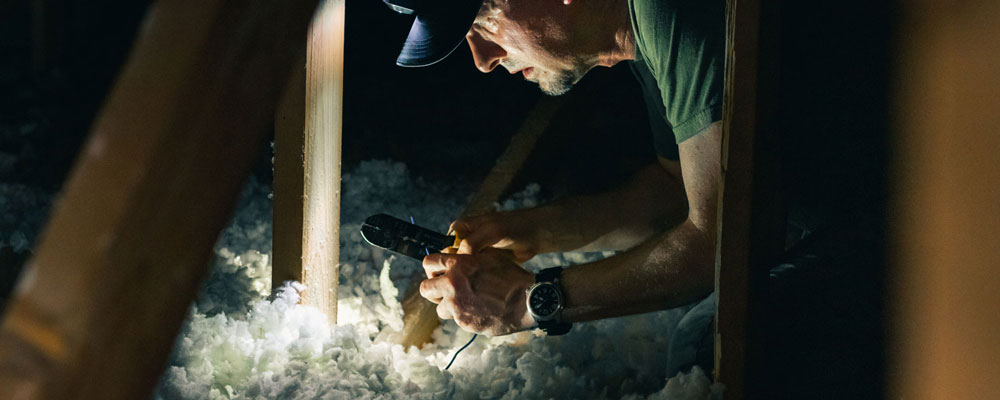
As fall transitions to winter, it's time to start thinking about weatherizing your home for the cold months ahead. In the spirit of giving, we want to show you some ways that you can save money and energy this winter through weatherization. So, let's dig in.
Insulation
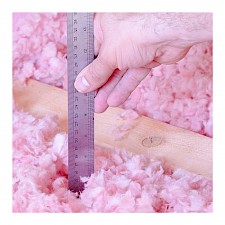
Insulation is the perfect place to start when it comes to weatherizing your home. A well-insulated home can significantly reduce your heating and cooling bills throughout the year and will keep your home at a more consistent temperature, keeping you comfortable year-round.
Although you may not notice it, there are many common trouble areas in homes where air can freely pass between outdoor and indoor air. This air leakage occurs when outside air enters and your conditioned indoor air leaves your house uncontrollably through cracks and openings. This is where insulation comes into play. Through the proper use of insulation, you can combat the majority of leaks throughout your home.
On average, homes with insulation save up to 20% on their heating and cooling costs, and by adding insulation to attics, floors, crawl spaces, accessible basement rim joints, and other problem areas for leaks, you can save up to 10% on your total energy costs.
Types of Insulation
There are six types of insulation on the market that serve their respective purposes depending on the problem area. Those six types of insulation are:
- Blankets, including batts and rolls.
- Blankets, including batts and rolls, are the most common types of insulating in the United States. If you have seen the big pink rolls of insulation, those are a type of blanket insulation. However, there are more variants of blanket insulation than just the big pink rolls.
- Loose Fill
- Loose-fill insulation is a type of insulation that is adaptable and can conform to any space without disturbing structures or finishes.
- Sprayed or foamed-in-place
- Sprayed or foamed-in-place insulation is a type of insulation that is best for filling small cavities.
- Rigid Insulation
- Rigid insulation is a type of insulation commonly used from the roof to the foundation, and it reduces energy loss through the house frame
- Reflective Insulation
- Reflective insulation is the most effective in reducing downward heat flow.
- Radiant Barrier
- Radiant Barrier Insulation is very useful in hot, sunny climates because it helps keep the home cooler.
The Cost of Insulation and R-Value
Insulation costs vary based on the material and its R-value. The R-value of insulation is the unit used to explain its ability to reduce heat flow. The greater the R-value, the more the heat flow is reduced. Energy.gov developed a table of general averages for different types of insulation, their R-value, their cost per square foot, and the cost per square foot per R-value.
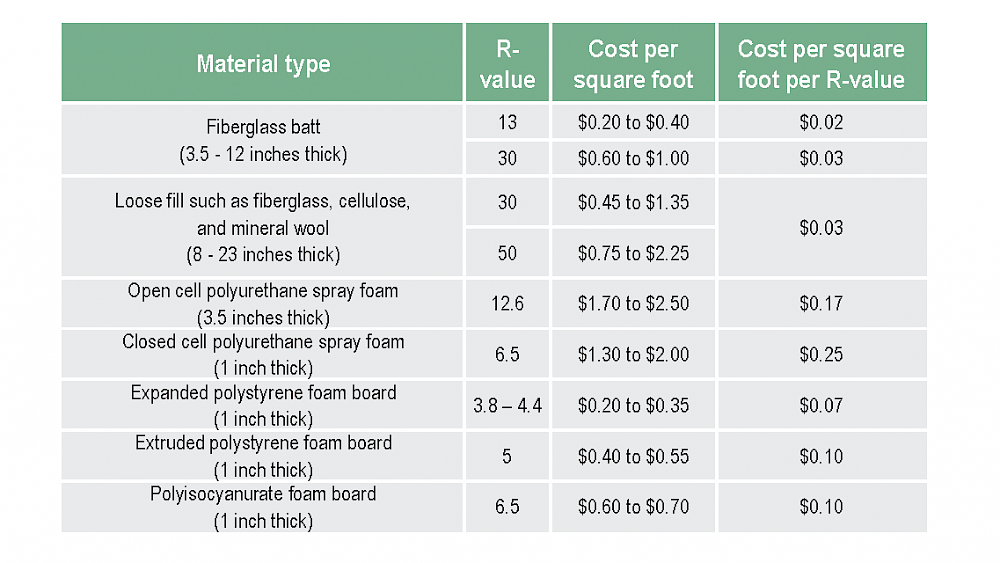
Energy.gov also developed a chart of the U.S. to show which R-value you should seek out depending on your location.

Getting started.
Even if you already have insulation installed, a certified contractor can evaluate your home's current R-value and recommend whether or not additional R-value is needed along with the types of insulation you will likely need. The table above suggests R-values by U.S. location.
If you're interested in improving your home without having to pay a contractor, we've come up with some products below that will help.
1. Frost King 42x62 Shrink & Seal Window Kit
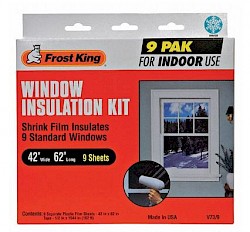
This kit features a crystal-clear plastic sheet that shrinks tight and wrinkle-free with an ordinary handheld hairdryer. It can be easily installed on metal, painted, varnished wood, or vinyl-clad window frames with the double-face tape provided.
- Keeps drafts out and helps lower energy bills
- Clear Polyolefin material
- For use with 9 standard windows
- Includes mounting tape
2. Frost King 5/16-Inch x 17-Foot White Weatherstripping
 The Frost King X-Treme White Rubber Weatherstrip Tape will not harden, crack, or freeze, down to -40F. It is a high-compression product that will spring back to shape even after long exposure to subfreezing conditions.
The Frost King X-Treme White Rubber Weatherstrip Tape will not harden, crack, or freeze, down to -40F. It is a high-compression product that will spring back to shape even after long exposure to subfreezing conditions.
- 1 roll of 5/16-inch wide x 1/4-inch thick x 17-foot long tape
- Self-adhesive application weatherstrip
- Cushioned and ribbed
- Fits gaps up to 1/8 inch
3. Frost King 15-Foot Insulating Pipe Wrap
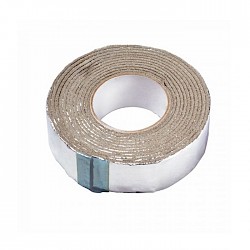 The Frost King Pipe Insulating Pipe Wrap Tape is a simple way to insulate both hot and cold pipes. On hot pipes, the tape prevents wasteful heat loss to save energy and money. On cold pipes, it can stop sweaty pipes which can cause mold. It is also great for dampening sounds and vibrations throughout the house.
The Frost King Pipe Insulating Pipe Wrap Tape is a simple way to insulate both hot and cold pipes. On hot pipes, the tape prevents wasteful heat loss to save energy and money. On cold pipes, it can stop sweaty pipes which can cause mold. It is also great for dampening sounds and vibrations throughout the house.
- Self-adhesive foam and foil tape
- Easy application
- Use to insulate hot or cold pipes
- 1 roll measuring 2-Inch X 1/8-Inch X 15-feet
4. Black & Decker Thermal Leak Detector TLD100
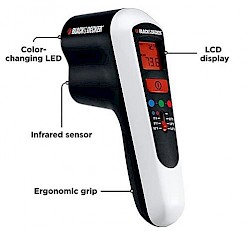 Save on your home’s heating and cooling costs by detecting and repairing leaks in locations like windows, walls, ductwork, drafty fireplaces, and more. A color-changing LED and easy-to-read display screen gives you quick and intuitive feedback, while the ergonomic design provides a comfortable grip. A 5-step guide is included to help you fix simple leaks.
Save on your home’s heating and cooling costs by detecting and repairing leaks in locations like windows, walls, ductwork, drafty fireplaces, and more. A color-changing LED and easy-to-read display screen gives you quick and intuitive feedback, while the ergonomic design provides a comfortable grip. A 5-step guide is included to help you fix simple leaks.
- Uses infrared sensors to measure surface temperatures. It performs within the ranges as specified for home repair use and should not be used to check the temperature of living beings
- Helps homeowners track down power-draining drafts
- Plugging leaks can save up to 20% on heating and cooling costs.
- Plastic housing with ergonomically formed grip for ease of use
- Model ID TLD100
5. Attic Tent AT-4 25"x54"x13"
 Insulating your attic hatch door is an effective way to reduce heat losses from your living area into the attic. The Attic Tent is a specially engineered patented insulator designed to create an air transfer barrier between your attic and living areas. The Attic Tent will cover the attic hatch reducing heat loss while preserving easy access into your attic. It can also prevent blown insulation from falling from the attic each time you open your attic stair door. It is lightweight durable and easy to install. The Attic Tent will fit around the outside of the attic stair frame and be secured with staples. You may add a bead of caulk around the seam to help to ensure a more airtight fit.
Insulating your attic hatch door is an effective way to reduce heat losses from your living area into the attic. The Attic Tent is a specially engineered patented insulator designed to create an air transfer barrier between your attic and living areas. The Attic Tent will cover the attic hatch reducing heat loss while preserving easy access into your attic. It can also prevent blown insulation from falling from the attic each time you open your attic stair door. It is lightweight durable and easy to install. The Attic Tent will fit around the outside of the attic stair frame and be secured with staples. You may add a bead of caulk around the seam to help to ensure a more airtight fit.
Subscribe
Resources
Customer Testimonials
Lets Talk!
Reach your customers & Exceed your goals
Contact EFI

